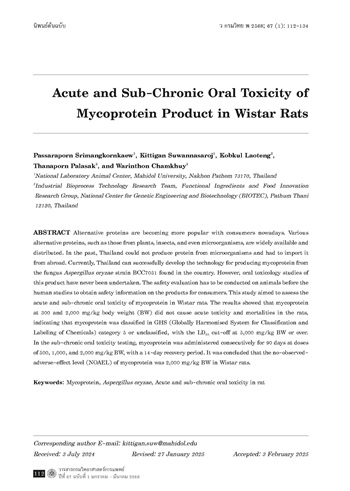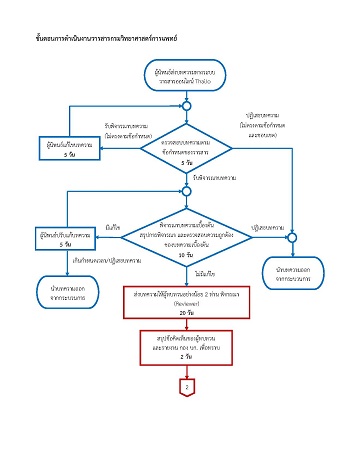ความเป็นพิษเฉียบพลันและพิษกึ่งเรื้อรังทางปากของผลิตภัณฑ์ Mycoprotein ในหนูแรทสายพันธุ์ Wistar
ความเป็นพิษเฉียบพลันและพิษกึ่งเรื้อรังทางปากของ Mycoprotein
คำสำคัญ:
Mycoprotein, Aspergillus oryzae, การทดสอบความเป็นพิษเฉียบพลันและพิษกึ่งเรื้อรังในหนูบทคัดย่อ
โปรตีนทางเลือกกำลังเป็นที่นิยมในผู้บริโภคมากขึ้น จึงมีผลิตภัณฑ์โปรตีนทางเลือก เช่น โปรตีน จากพืช แมลง และจุลินทรีย์ออกมาจำหน่ายจำนวนมาก ที่ผ่านมาประเทศไทยยังไม่สามารถผลิตโปรตีนจากจุลินทรีย์ได้เองต้องมีการนำเข้าจากต่างประเทศ ปัจจุบันประเทศไทยสามารถพัฒนาเทคโนโลยีการผลิตโปรตีน mycoprotein ได้สำเร็จจากเชื้อรา Aspergilus oryzae สายพันธุ์ BCC7051 และยังไม่มีการศึกษาพิษวิทยาทางปากของผลิตภัณฑ์ดังกล่าว ซึ่งการประเมินความปลอดภัยต้องดำเนินการในสัตว์ทดลองก่อนที่จะศึกษาในมนุษย์ เพื่อให้ได้ข้อมูลความปลอดภัยของผลิตภัณฑ์ต่อผู้บริโภค การศึกษานี้มีวัตถุประสงค์เพื่อประเมินความเป็นพิษเฉียบพลันและพิษกึ่งเรื้อรังทางปากของ mycoprotein ในหนูแรทสายพันธุ์ Wistar ผลการทดสอบพบว่า mycoprotein ขนาด 300 และ 2,000 มิลลิกรัมต่อกิโลกรัมของน้ำหนักสัตว์ทดลอง ไม่ก่อให้เกิดความเป็นพิษเฉียบพลันและการตายในสัตว์ทดลอง แสดงให้เห็นว่า mycoprotein จัดอยู่ในระบบการจัดกลุ่มสารเคมี การติดฉลาก และการแสดงรายละเอียดบนเอกสารข้อมูลความปลอดภัยสากลหมวดที่ 5 หรือไม่ระบุประเภท มี LD50 ที่ 5,000 มิลลิกรัมต่อกิโลกรัมขึ้นไปของน้ำหนักตัวสัตว์ทดลอง ในการทดสอบความเป็นพิษทางปากแบบกึ่งเรื้อรัง การให้โปรตีนชนิดนี้ติดต่อกันเป็นเวลา 90 วัน ที่ขนาด 500 1,000 และ 2,000 มิลลิกรัมต่อกิโลกรัมของน้ำหนักสัตว์ทดลอง และในกลุ่มพักฟื้นที่มีเวลาพักฟื้น 14 วัน สรุปได้ว่าขนาด mycoprotein ที่มากที่สุดที่ได้รับต่อเนื่องเป็นเวลานานโดยไม่ก่อให้เกิดอันตรายที่ร้ายแรงต่อร่างกายต่อวันในสัตว์ทดลอง คือ 2,000 มิลลิกรัมต่อกิโลกรัมของน้ำหนักตัวสัตว์ทดลอง
เอกสารอ้างอิง
Ritala A, Hakkinen ST, Toivari M, Wiebe MG. Single cell protein—state-of-the-art, industrial landscape and patents 2001–2016. Front Microbiol. [serial online]. 2017; [cited 2023 Sep 21]; 8: [18 screens]. Available from: URL: https://doi.org/10.3389/fmicb.2017.02009.
Derbyshire E, Ayoob K-T. Mycoprotein: nutritional health and properties. Nutr Today 2019; 54(1): 7-15.
Souza Filho PF, Nair RB, Andersson D, Lennartsson PR, Taherzadeh MJ. Veganmycoprotein concentrate from pea-processing industry byproduct using edible flamentous fungi. Fungal Biol Biotechnol. [serial online]. 2018; [cited 2023 Sep 21]; 5: [10 screens]. Available from: URL: https://fungalbiolbiotech.biomedcentral.com/articles/10.1186/s40694-018-0050-9.
Hashempour-Baltork F, Khosravi-Darani K, Hosseini H, Farshi P, Reihani S SF. Mycoproteins as safe meat substitutes. J Clean Prod. [serial online]. 2020; [cited 2023 Sep 21]; 253: [10 screens]. Available from: URL: https://doi.org/10.1016/j.jclepro.2020.119958.
Wiebe M. Myco-protein from Fusarium venenatum: a well-established product for human consumption. Appl Microbiol Biotechnol 2002; 58(4): 421-7.
Moore D, Chiu SW. Chapter 12 - Impact of developmental, physiological and environmental studies on the commercial cultivation of mushrooms. In: Watling R, Frankland JC, Ainsworth AM, Isaac S, Robinson CH, editors. Tropical mycology. Vol. 1, macromycetes. Wallingford: CAB lnternational; 2002. pp. 167–81.
Food biotechnology. Mycoprotein: alternative protein from fungi. [online]. [cited 2024 Dec 26]; [1 screen]. Available from: URL: https://www.foodfocusthailand.com/eBook/208/mobile/index.html?fbclid=IwAR1loj1iccKJfHAajBtdvT77UB-3-BoaG8OB8BQJHkMrR_Vy4hl7c7YLJ9M#p=20.
Thammarongtham C, Nookaew I, Vorapreeda T, Srisuk T, Land ML, Jeennor S, et al. Genome characterization of oleaginous Aspergillus oryzae BCC7051: a potential fungal-based platform for lipid production. Curr Microbiol 2018; 75(1): 57-70.
The Organisation for Economic Co-operation and Development (OECD). Test no. 423: OECD guidelines for the testing of chemicals, acute oral toxicity - acute toxic class method. [online]. 2001; [cited 2023 May 24]; [14 screens]. Available from: URL: https://read.oecd-ilibrary.org/environment/test-no-423-acute-oral-toxicity-acute-toxic-classmethod_9789264071001-en.
The Organisation for Economic Co-operation and Development (OECD). Test no. 408: OECD guidelines for the testing of chemicals, repeated dose 90-day oral toxicity study in rodents. [online]. 2018; [cited 2023 May 24]; [16 screens]. Available from: URL: https://read.oecd-ilibrary.org/environment/test-no-408-repeated-dose-90-day-oral-toxicitystudy-in-rodents_9789264070707-en.
AOAC official method 981.10, Crude protein in meat. Block digestion method. In: AOAC official methods. [online]. 1983; [cited 2024 Oct 22]; [2 screens]. Available from: URL: http://www.aoacofficialmethod.org/index.php?main_page=product_info&cPath=1&products_id=2870.
AOAC official method 920.153, Ash of meat. In: AOAC official methods. [online]. 1920; [cited 2024 Oct 22]; [1 screen]. Available from: URL: http://www.aoacofficialmethod.org/index.php?main_page=product_info&cPath=1&products_id=1694.
AOAC official method 922.06, Fat in flour. Acid hydrolysis method. In: AOAC official methods. [online]. 1922; [cited 2024 Oct 22]; [1 screen]. Available from: URL: http://www.aoacofficialmethod.org/index.php?main_page=product_info&cPath=1&products_id=1860.
AOAC official method 985.29, Total dietary fiber in foods. Enzymatic-gravimetric method. In: AOAC official methods. [online]. 2003; [cited 2024 Oct 22]; [2 screens]. Available from: URL: http://www.aoacofficialmethod.org/index.php?main_page=product_info&cPath=1&products_id=572.
AOAC official method 984.27, Calcium, copper, iron, magnesium, manganese, phosphorus, potassium, sodium, and zinc in infant formula. Inductively coupled plasma: emission spectroscopic method (ICP-OES). In: AOAC official methods. [online]. 1986; [cited 2024 Oct 22]; [2 screens]. Available from: URL: http://www.aoacofficialmethod.org/index.php?main_page=product_info&cPath=1&products_id=2126.
Sullivan DM, Carpenter DE, editors. Methods of analysis for nutrition labeling. Arlington, Va: AOAC International; 1993. p. 76-106.
Maturin L, Peeler JT. Chapter 3: aerobic plate count. In: Bacteriological analytical manual. Silver Spring, MD: U.S. Food and Drug Administration. [online]. 2001; [cited 2024 Oct 22]; [12 screens]. Available from: URL: https://www.fda.gov/food/laboratory-methods-food/bamchapter-3-aerobic-plate-count.
AOAC official method 991.14, Coliform and escherichia coli counts in foods. Dry rehydratable film (petrifilm? E.coli/coliform count plate? and petrifilm? coliform count plate?) methods. In: AOAC official methods. [online]. 2002; [cited 2024 Oct 22]; [6 screens]. Available from: URL: http://www.aoacofficialmethod.org/index.php?main_page=product_info&cPath=1&products_id=849.
ISO 6579-1:2017/Amd 1:2020, Microbiology of the food chain - horizontal method for the detection, enumeration and serotyping of Salmonella - Part 1: Detection of Salmonella spp. - Amendment 1: Broader range of incubation temperatures, amendment to the status of Annex D, and correction of the composition of MSRV and SC. Geneva, Switzerland: International Organization for Standardization; 2020.
AOAC official method 986.15, Arsenic, cadmium, lead, selenium, and zinc in human and pet foods by inductively coupled plasma mass spectrometry technique (ICP-MS). In: AOAC official methods. [online]. [cited 2024 Oct 22]; [3 screens]. Available from: URL: https://www.aoacofficialmethod.org/index.php?main_page=product_info&products_id=203.
AOAC official method 999.10, Lead, cadmium, zinc, copper, and iron in foods by inductively coupled plasma mass spectrometry technique (ICP-MS). In: AOAC official methods. [online]. 2002; [cited 2024 Oct 22]; [3 screens]. Available from: URL: https://img.21food.cn/img/biaozhun/20100108/177/11285281.pdf.
AOAC International. Mercury by inductively coupled plasma mass spectrometry technique (ICP-MS). Rockville, Maryland: AOAC International; 2023.
AOAC official method 991.31, Aflatoxins (AFs; sum of aflatoxins B1, B2, G1, and G2) in corn, raw peanuts, and peanut butter. In: AOAC official methods. [online]. [cited 2024 Oct 22]; [7 screens]. Available from: URL: https://www.aoacofficialmethod.org/index.php?main_page=product_info&products_id=1723.
AOAC official method 994.08, Aflatoxins in corn, almonds, Brazil nuts, peanuts, and pistachio nuts. In: AOAC official methods. [online]. 2000; [cited 2024 Oct 22]; [2 screens]. Available from: URL: https://img.21food.cn/img/biaozhun/20100108/177/11285229.pdf.
AOAC official method 2000.09, Ochratoxin A in roasted coffee immunoaffinity column HPLC method first action 2000. In: AOAC official methods. [[online]. [cited 2024 Oct 22]; [3 screens]. Available from: URL: https://www.aoacofficialmethod.org/index.php?main_page=product_info&cPath=1&products_id=1822.
National Research Council, Division on Earth and Life Studies, Institute for Laboratory Animal Research, Committee for the Update of the Guide for the Care and Use of Laboratory Animals, editors. Guide for the care and use of laboratory animals. 8th ed. Washington, DC: National Academies Press; 2011.
Institutional Animal Care and Use Committee. Guidelines for euthanasia of rodent fetuses and neonates. [online]. 2013; [cited 2023 Jun 2]; [3 screens]. Available from: URL: https://oacu.oir.nih.gov/system/files/media/file/2021-02/b4_rodent_euthanasia_pup.pdf.
Sarstedt M, Mooi E. Hypothesis testing and ANOVA. In: Sarstedt M, Mooi E, editors. A concise guide to market research. 3rd ed. Germany: Springer; 2011. p. 113-60.
Frazier KS, Seely JC, Hard GC, Betton G, Burnett R, Nakatsuji S, et al. Proliferative and nonproliferative lesions of the rat and mouse urinary system. Toxicol Pathol 2012; 40(4 Suppl): 14S-86S.
Srimangkornkaew P, Suwannasaroj K, Yottharat P, Sirimontaporn A. Historical control data from repeated dose 90-days oral toxicity studies of wistar rats (Mlac:WR). Bull Dept Med Sci 2021; 63(3): 595-606.
Kort MD, Weber K, Wimmer B, Wilutzky K, Neuenhahn P, Allingham P, et al. Historical control data for hematology parameters obtained from toxicity studies performed on different Wistar rat strains: acceptable value ranges, definition of severity degrees, and vehicle effects. Toxicol Res Appl 2020; 4: 1-32.
Berridge BR, Mowat V, Nagai H, Nyska A, Okazaki Y, Clements PJ, et al. Non-proliferative and proliferative lesions of the cardiovascular system of the rat and mouse. J Toxicol Pathol 2016; 29(3 Suppl): 1S-47S.
Ajayi AF, Akhigbe E. Staging of the estrous cycle and induction of estrus in experimental rodents: an update. Fertil Res Pract 2020; 6: 5. (15 pages).
Dixon D, Alison R, Bach U, Colman K, Foley GL, Harleman JH, et al. Nonproliferative and proliferative lesions of the rat and mouse female reproductive system. J Toxicol Pathol 2014; 27(3-4 Suppl): 1S-107S.
Westwood FR. The female rat reproductive cycle: a practical histological guide to staging. Toxicol Pathol 2008; 36(3): 375-84.
Willard-Mack CL, Elmore SA, Hall WC, Harleman J, Kuper CF, Losco P, et al. Nonproliferative and proliferative lesions of the rat and mouse hematolymphoid system. Toxicol Pathol 2019; 47(6): 665-783.
Baiocco AB, Balme E, Bruder M, Chandra S, Hellmann J, Hoenerhoff MJ, et al. Nonproliferative and proliferative lesions of the rat and mouse endocrine system. J Toxicol Pathol 2018; 31(3 Suppl): 1S-95S.
Thoolen B, Maronpot RR, Harada T, Nyska A, Rousseaux C, Nolte T, et al. Proliferative and nonproliferative lesions of the rat and mouse hepatobiliary system. Toxicol Pathol 2010; 38 (7 Suppl): 5S-81S.
Chentouf A, Looten P, Srinivasan M, Srinivas A, Murkunde YV. Subchronic toxicological effects of pea protein isolate (nutralys) on Wistar rats: a ninety-day dietary. J Toxicol Environ Health 2013; 103: 225-33.
Bauter MR, Mendes O. Subchronic toxicity of lyophilized apoaequorin protein powder in Sprague-Dawley rats. Toxicol Res Appl 2018; 2: 1-15.
Choi B, Glavits R, Murbach TS, Endres JR, Hirka G, Szakonyine IP. 90-day oral toxicity study in rats of a protein-rich powder derived from Xanthobacter sp. SoF1. J Appl Toxicol 2024; 44(11): 1816-30.

ดาวน์โหลด
เผยแพร่แล้ว
รูปแบบการอ้างอิง
ฉบับ
ประเภทบทความ
สัญญาอนุญาต
ลิขสิทธิ์ (c) 2025 วารสารกรมวิทยาศาสตร์การแพทย์

อนุญาตภายใต้เงื่อนไข Creative Commons Attribution-NonCommercial-NoDerivatives 4.0 International License.



